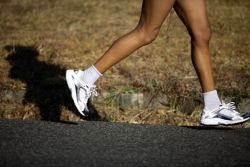 The clocks are set forward, the temperature is starting to inch toward
beach-worthy weather and the flowers are blooming. Spring is officially sprung, and with it
comes a new and exciting season of outdoor activities and sports. After
hibernating all winter, our bodies can be a little rusty, so jumping full-speed
back into activity (even for seasoned athletes) can actually do more harm
than good. Because what good is springtime weather if we're stuck
inside on the sofa nursing an
unnecessary injury? So, before you go from 0 to 100 on the springtime exercise odometer,
take these simple tips into consideration to keep yourself strain-, sprain-
and knee-injury free.
The clocks are set forward, the temperature is starting to inch toward
beach-worthy weather and the flowers are blooming. Spring is officially sprung, and with it
comes a new and exciting season of outdoor activities and sports. After
hibernating all winter, our bodies can be a little rusty, so jumping full-speed
back into activity (even for seasoned athletes) can actually do more harm
than good. Because what good is springtime weather if we're stuck
inside on the sofa nursing an
unnecessary injury? So, before you go from 0 to 100 on the springtime exercise odometer,
take these simple tips into consideration to keep yourself strain-, sprain-
and knee-injury free.
Warm up and cool down. This may sound like the most basic of recommendations for anyone who exercises, but it's still one of those golden rules people tend to throw to the wind, and it's one of the most important. Intense physical activity on "cold" muscles can be a recipe for injury, and a simple warm-up prevents that by loosening the muscles to be more flexible, thus increasing range of motion and ultimately allowing the body to move more naturally. Take 3 to 5 minutes for a quick jog in place or cycling on a stationary bike, and then give your muscles a solid stretch. The key here? Don't neglect your hips. Believe it or not, vulnerable knees are most often the result of weak hip muscles (not necessarily weak quadriceps muscles, as a lot of people believe), so hip rotation as part of a warm-up is always highly recommended. That said, it's crucial to properly stretch all the muscle groups that work in tandem to support the knees, such as the hamstrings, quads, glutes and even your core muscles – which play an important role in proper body mechanics necessary to prevent injury. Remember, too, that the cool down is just as important as the warm-up; a few minutes of gentle stretching is all you need to ease your body into recovery mode and prepare for the next workout.
Go for a jog. Want to do something beneficial for your knees? Warm up, and then hit the pavement for a nice jog. Many recent studies suggest running is not harmful to the knee joints, as was previously believed; these studies even show that consistent daily jogging is beneficial and can reduce inflammation and protect the knees from degenerative conditions. A short daily jog around the block or on the treadmill will help stimulate self-repair of the knee and strengthen all of its working parts. What a win-win for exercise enthusiasts: great cardiovascular activity for the whole body and a built-in protection package to keep your knees operating at optimal levels.
Consistency is key. Just as consistent jogging is beneficial to the knees, the same holds true for all other exercise programs. Suddenly throwing your body into an exercise regime only once or twice a week (weekends only, for example) can be grounds for injury. Instead, aim for at least 20 to 30 minutes of moderate activity daily to gradually increase your fitness level and give your body a chance to adapt to the movements. Moving your body with the correct form and body mechanics is a major key in injury prevention, and the more you practice, the better form you'll develop.
When in doubt, get it checked out. If any type of knee pain is preventing you from engaging in sports or other activities you enjoy, have it evaluated by a specialist as soon as possible. I can't tell you how many orthopedic and knee injuries may have been resolved with some intensive TLC, but instead turn into catastrophic damage because they were shrugged off or played through. No matter what activity you're engaging in or where the discomfort is located, pain is your body's way of telling you that something is wrong. Listen to it.
For more information on this please visit here.
